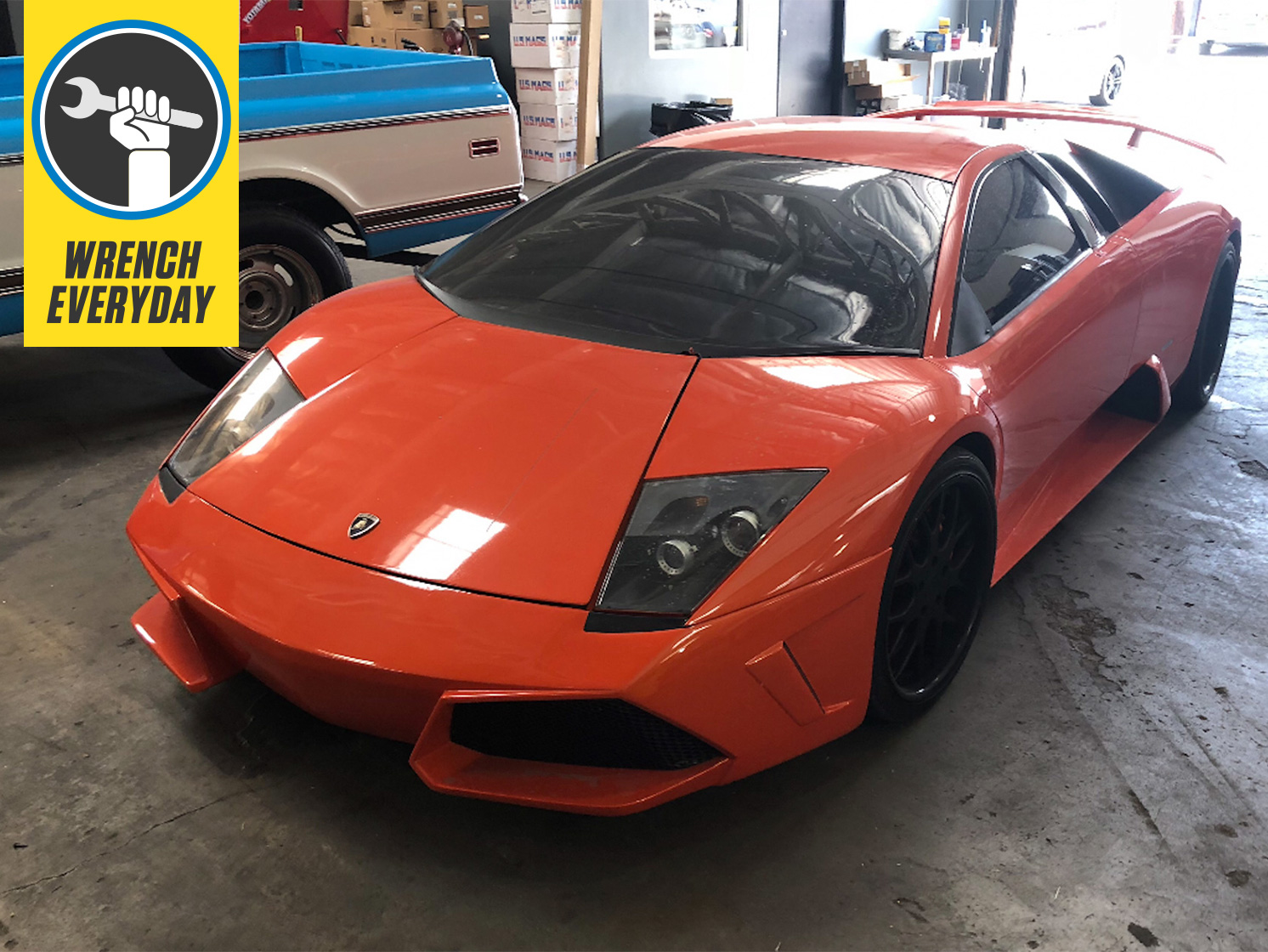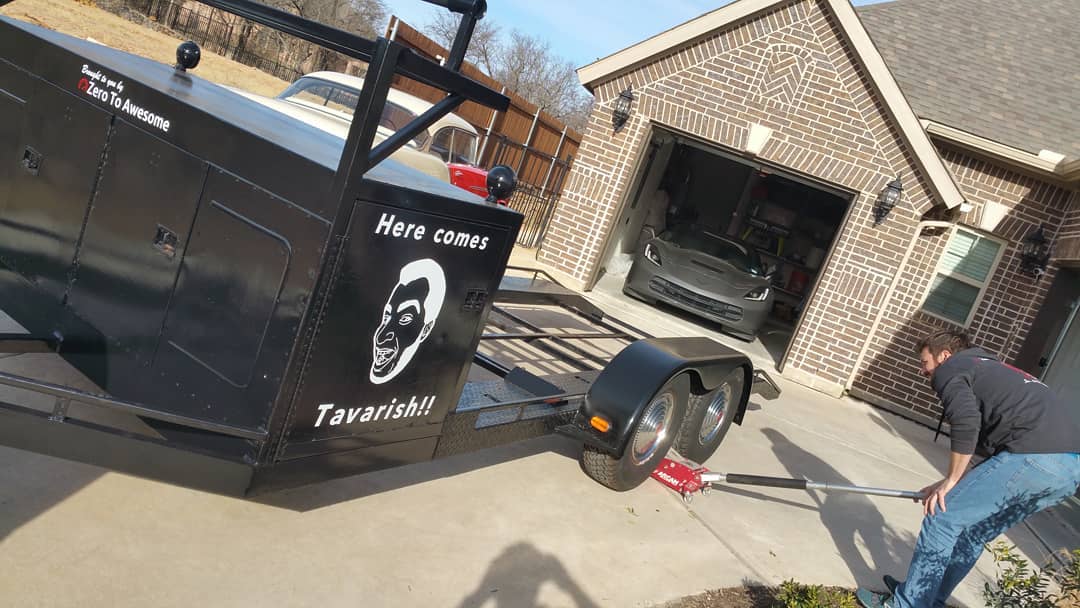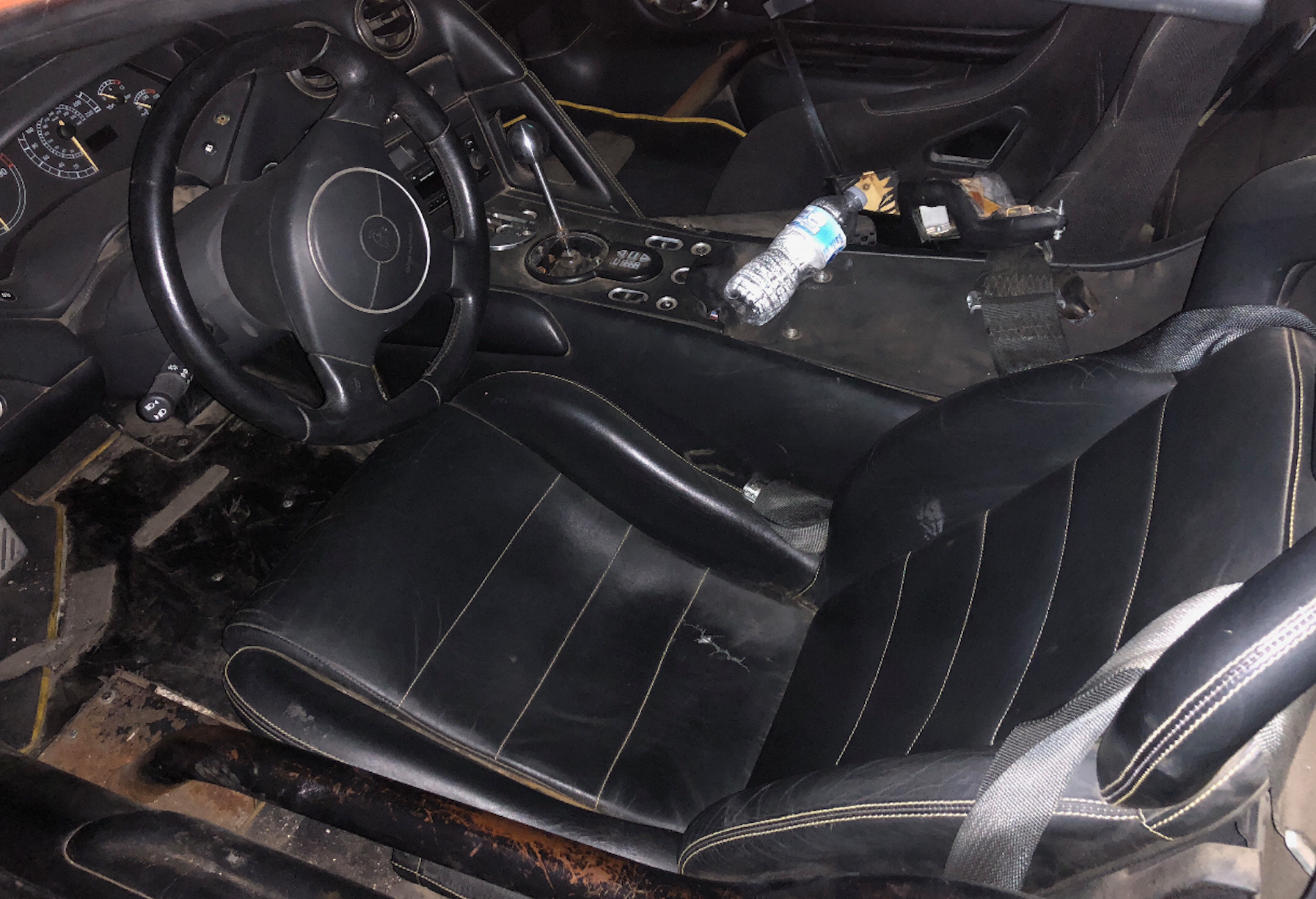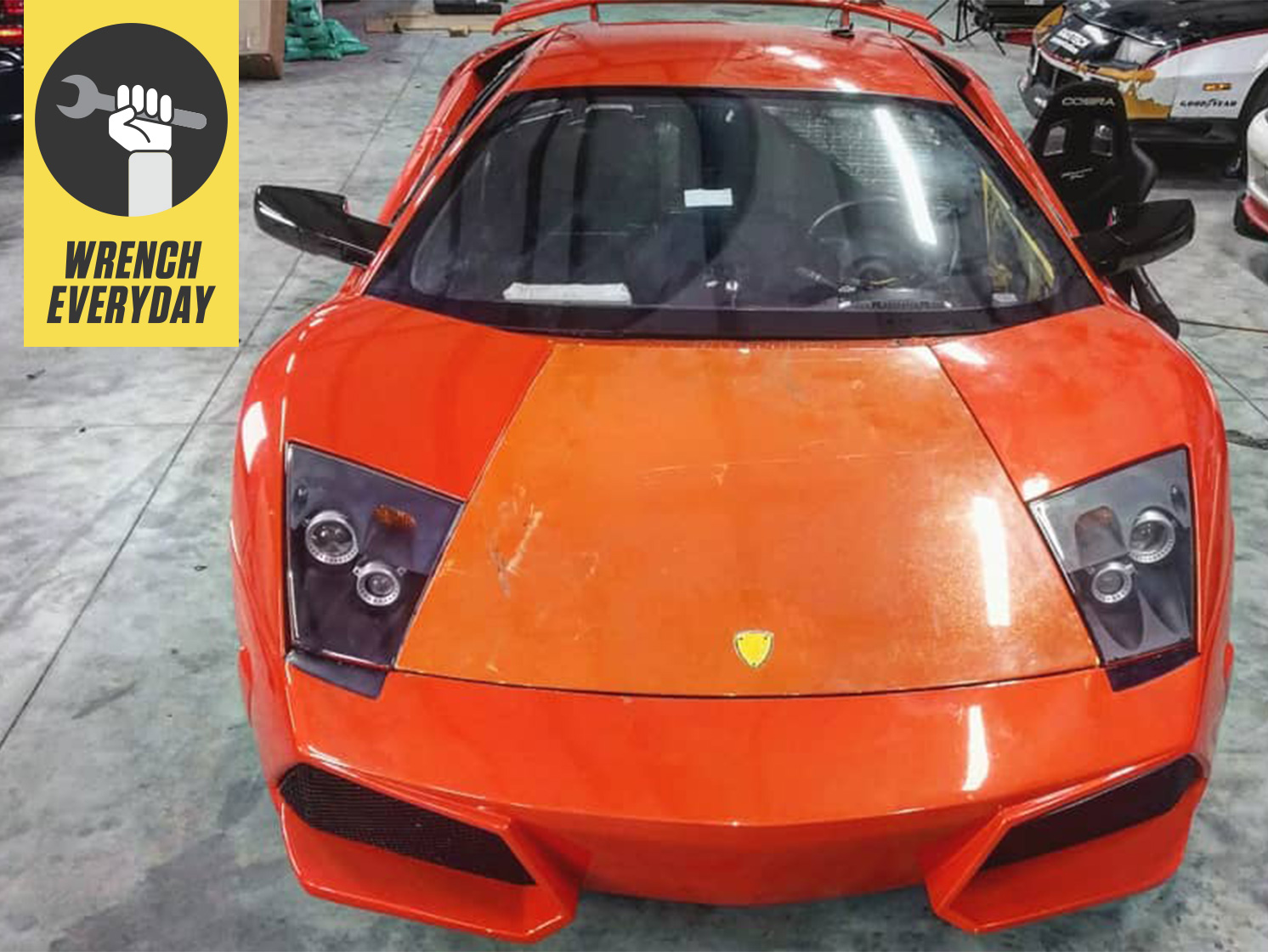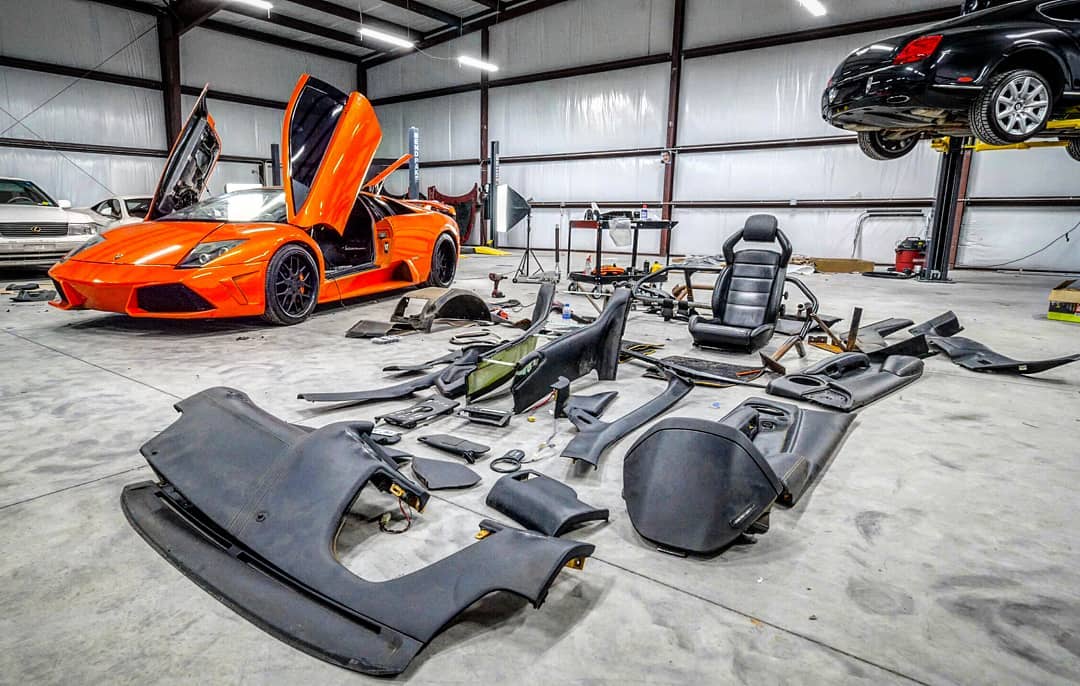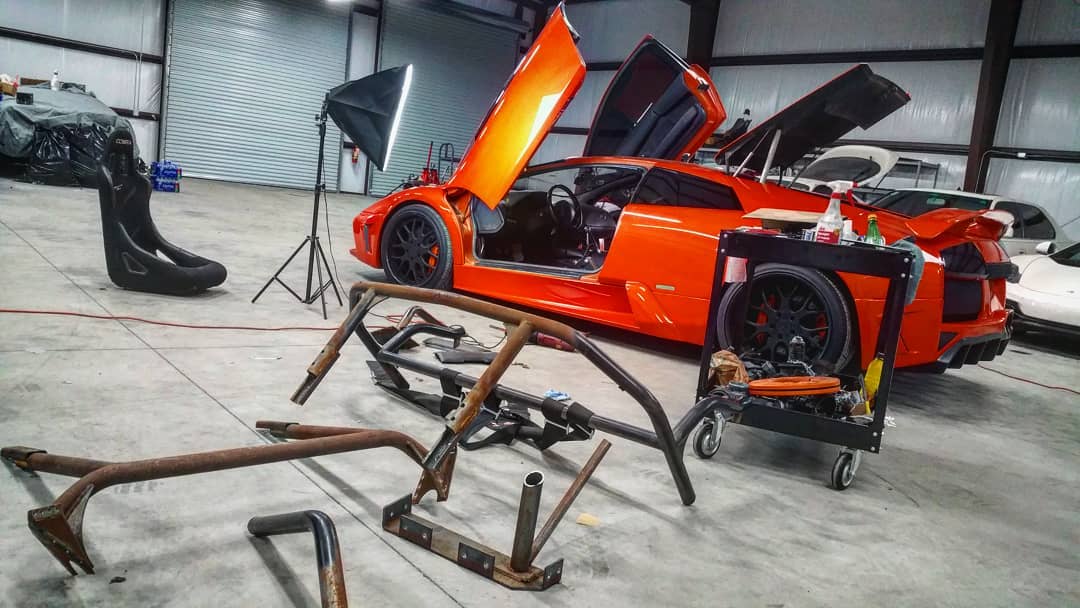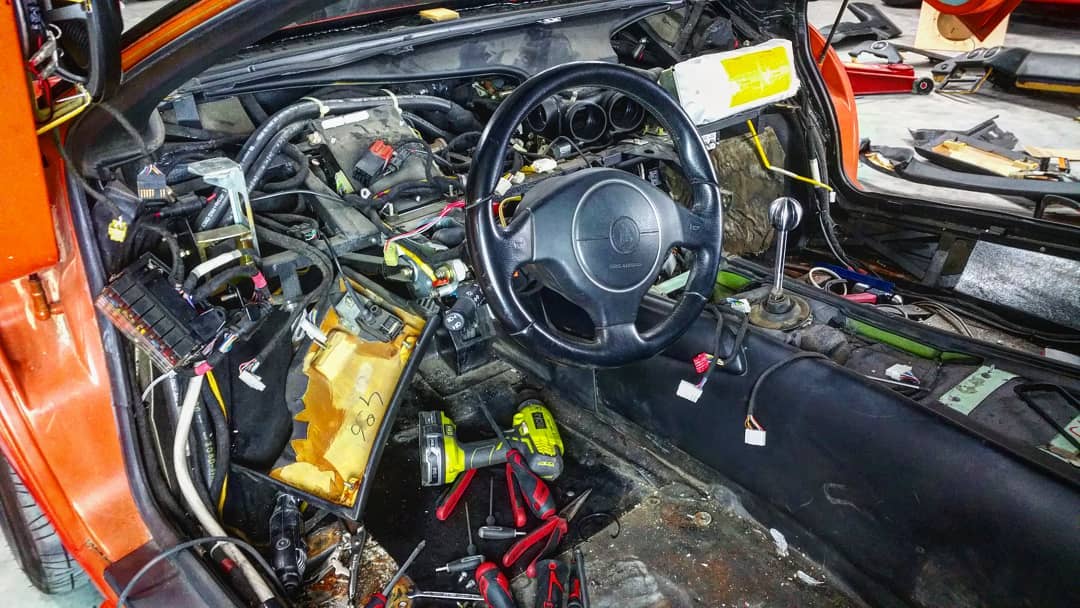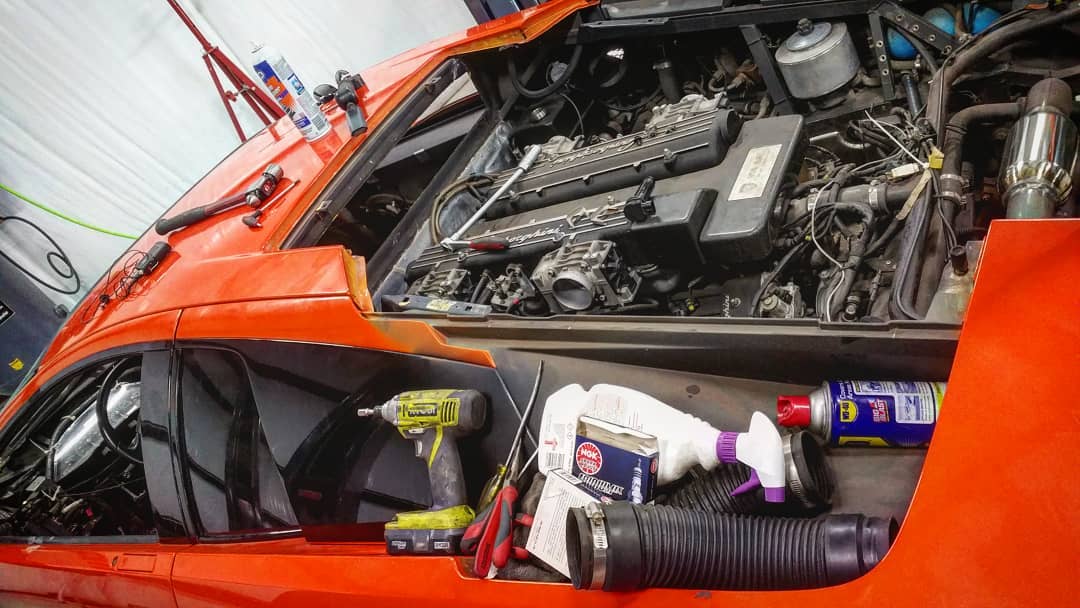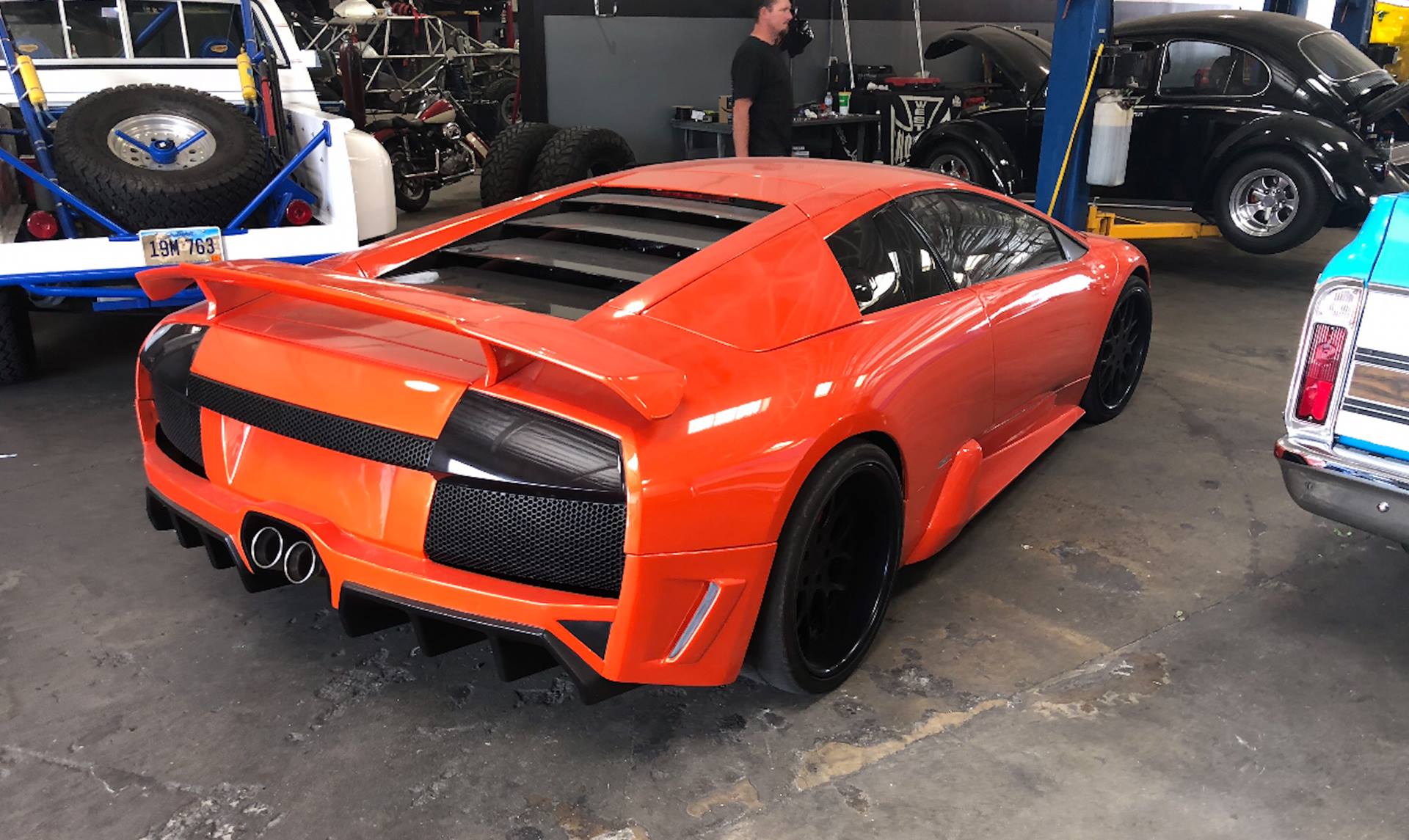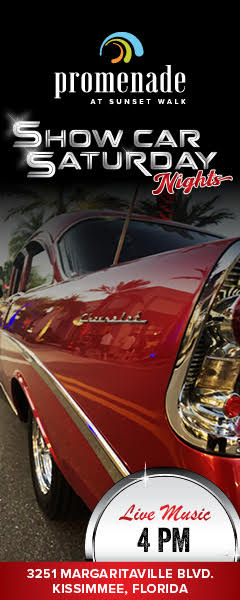Written by Freddy “Tavarish” Hernandez and published by Haggerty
Supercar ownership ain’t what it used to be. Pop open any social media app and you'll be thrust into a sea of barely-post-pubescent man-children braying about how getting their sparkly one-off Ferrari three weeks out of high school was a result of 49 percent “rising”, 49 percent “grinding”, and… two percent having a semi-absent dad who served as lead counsel for ExxonMobil. The doe-eyed, car-curious youth out there will be forgiven for thinking that not only are luxury, sports and exotic cars incredibly easy to attain, and the hardest thing about living with them is picking the color of the next one.
To remedy this, I've decided to inject a bit of gritty realism into the automotive landscape by purchasing and attempting to restore what is undoubtedly the worst running, cheapest, and most haggard example of Lamborghini 12-cylinder Murcielago supercar in the world. As a cherry on top of this rusty and oversprayed sundae, this particular automotive nugget was screen used in The Fate Of The Furious, a movie that made more money at the box office than the annual GDP of Antigua.
And I'd be doing everything on a budget. By myself.
For those of you who are new to my automotive mishaps and occasional triumphs, I run a YouTube channel that seeks to teach people about interesting cars they wouldn't otherwise see, from a frugal do-it-yourselfer's perspective. I do this by hoarding the kinds of supercars that wouldn't fit in at buy-here-pay-here lot, much less a squeaky clean Instagram influencer's “paid partnership” story.
My current fleet includes:
- a barely-running Bentley Continental GT that spent the better part of a decade in Russia illegally
- a 163,000 mile, 600 horsepower Mercedes-Benz S-Class that I drive every day
- a Lamborghini Gallardo that suffered a small fire in its past
- a Ferrari F355 that suffered a large fire in its past
- and a mid-90s Toyota Supra that gets challenged to multiple street races daily, despite making all of 120 horsepower at the rear wheels.
The new-to-me Murcielago, however, was quite different than my usual fare of neglected exotica—this time, the automotive butchery was performed on purpose. To illustrate my point, I'll recall the entire sketchy story of how I bought this car, second in sketchiness to the car itself.
Several months ago, I was approached by a friend. The kind of friend who makes a habit of influencing people to empty their disappearing 401ks for questionable automotive purchases, livid wives be damned. That friend was transcontinental record holder, Lamborghini nut, and owner of multiple hoopties, Ed Bolian. He’s become an authority on his automaker of choice: Lamborghini, with a particular fondness for the Murcielago and its later model LP640/LP670 variants, having owned several himself. If anyone knew about these cars, it was this guy.
Bolian reached out to me with an unsolicited Facebook message, which was as impactful as it was devoid of any pertinent information.
“Hey man, do you want another cheap Lamborghini?”
The parts in my brain that, despite my best efforts, still get excited at obvious clickbait, registered an immediate “YES!” Over the next few minutes, I was given information with the same knowledge gaps you'd get in a Craigslist for-sale ad that was only posted because divorce is more expensive than getting rid of that project Harley softail in the backyard.
The major takeaways from our exchange were that through a friend of a friend, Bolian learned that a clean titled, running and impossibly orange 2003 Lamborghini Murcielago was for sale in Los Angeles, it was screen used in The Fate of The Furious as the movie's “hero car”, Tyrese Gibson had driven it in the film, it had a custom-built roll cage installed and it needed some work. The asking price was $80,000… which was about $100,000 less than the next cheapest running example.
Others privy to the same information and blessed with disposable income would likely jump at the chance to own this car. Ed himself wanted it, as we are both attracted to the same kind of broken automotive perfection. However, because his money was tied up elsewhere and I was the only other person dumb enough to consider this car without crying myself to sleep over the purchase afterwards, I was staring at the business end of a perfect storm.
Taking action, though, meant that I'd have to pay 80 grand to an unknown person across the country in the hopes that the car's $65,000 hand-built and film-abused V12 wouldn't throw a rod five miles after the title was signed over. That kind of risk is fine in the Craigslist clunker world I currently inhabit—but taking that same attitude and moving it up to the top tax bracket could be ruinously expensive for me.
If I've learned anything in life, however, it's that no great reward comes without great risk. So I hastily sold off my project Dodge Viper at a $2000 loss and fired those funds off as a deposit to a man in California who owned a warehouse with a number of iconic movie cars in it. I didn't feel I'd earned the right to haggle because I had to pay for the car in installments, like a normie. Without full payment on the table, I had no hand to play against a person who didn't need to put his broken Lambo on Lay-A-Way.
Approximately 90 days later, I had the remaining funds squared away and paid to the seller. I was given several assurances that not only was I getting the car, but that the warehouse owner would throw in a bunch of “bonus parts” that the movie studio had stashed somewhere. Sweet.
I had the hotels booked, and made arrangements for a double-axle car trailer that would transport the Murcielago in style. OK, maybe not in style, but it sure beat flat towing it, or, heaven forbid, driving it. You see, the idea was for me and a friend to take my nearly 300,000 mile, 19 year old Ford F350 diesel pickup from where I live in central Florida, acquire a trailer in Dallas, drive to the City of Angels, pick up the Lambo, then drive all the way back with a shiny orange Lamborghini in tow, without getting robbed—a round trip of more than 5000 miles, in the span of about 10 days.
The reason I didn't just have the damn thing shipped is because dealing with shipping companies is like dealing with the bomb squad. No matter how many times they say “everything is under control,” there still is a very real risk that things may blow up in your face. With the most expensive car I've ever purchased by a fair margin, you'd better believe that if someone was going to stuff it into a ditch or scratch the wheels while loading it under the influence of extreme sleep deprivation, it was gonna be me.
When D-day finally arrived, I packed a light suitcase with a totally ridiculous number of socks, gathered the saltiest and road-trippiest of foods, picked my friend up, and hit the open highway. One of the things I most enjoy about long road trips is what you learn about the people riding with you. For example, I learned that my travel buddy wasn't very comfortable driving a truck as large as mine, which meant that I was going to see every single one of those five thousand miles roll across the odometer firsthand. No biggie.
Once our California-bound one-truck convoy arrived in Dallas, we realized our first mistake: It had not occurred to anyone to actually measure the trailer we were scheduled to pick up to see if the behemoth of a car we were collecting would actually fit. This isn’t a problem when you buy an MGA—but the Murcielago is eighty-one inches wide, which doesn’t just exceed the loading width of most trailers. It exceeds the width of an F-350. Even the new ones.
I didn’t have the option of just walking away from the trailer in question, as it had been given to me by fans of my YouTube channel, a duo that call themselves “Zero To Awesome”. It was an abandoned race trailer that they acquired and refurbished especially for me, with thoughtful touches such as plastering a white vinyl likeness of my face on the side of the black trailer, with the caption “Here comes Tavarish!” While I truly appreciated the gesture of what was gearing up to be an amazing trailer for me to keep for free, it wasn't exactly subtle.
Apart from the styling efforts of the boys at Z2A, the main concern for me was to have a secured load on the back of my truck. The problem with this two-axled freebie was that the runners were 78 inches wide and the Lambo… well, as I mentioned, it’s around 81 inches wide. To put that into perspective, the car was exactly as wide as a Hummer H2, and almost an entire foot wider than a Nissan 350Z.
If for some reason I couldn't get the car on the trailer, I'd have no choice but to ship it, an endeavor that would cost me a ton of time and money. Also, my travel companion would never let me live it down. Seeing as we were halfway across the country with a trailer already hitched, however. I figured we'd sort it out when we got there. I mean, hell, I’d never actually measured a Murcielago. I’d just looked at Google, and Google could be wrong.
As you'll find out shortly, it wasn't.
After a glorious two-day drive in which one of our brand-new tires exploded on our brand-new trailer and embedded a brand-new skid mark in my brand-new undies, we successfully made it to the land of traffic, taxes, and THC. The trailer situation had laser-etched itself in my brain as a problem that needed immediate fixing, so I visited the shop of fellow YouTuber Rob Dahm, who had two things we needed to fix the major trailer issue: a Lamborghini Diablo that was a close analog to the Murcielago size-wise, and an angle grinder that could make some last-minute changes to the trailer if need be—and yeah, we needed be.
With the Diablo measured, I ground off the half-inch steel rails on either side of the trailer, which were only probably slightly structural. The runners were still too narrow, but having an inch of rear tire poking out on both sides was better than the car not fitting at all. From there, we departed for the main event, the reason why we, fueled by pork rinds, trail mix, and Chik-Fil-A, traveled west in search of orange automotive gold.
I was going to see my car, the car that gave me sleepless nights and anxious days for the last three months, for the very first time. As we pulled up to the inconspicuous shop, I could already see my orange monster past the giant metal roll-up doors. Its skateboard-like body was lower to the ground than I had imagined, a bit wider, and way, way more orange. Would it fit? Would it run? Would it blow up? All I knew was this: it would be an adventure.
Having already been lured into buying, sight-unseen, that Lamborghini Murcielago from The Fate of the Furious, I was finally in California, ready to collect my prize. It was not pretty. Or a prize. Or safe. It did run, which, as it turns out, was both promising and terrifying.
A cursory glance around the car revealed the reasons why it was listed at 50-percent-off market value, reasons that were as numerous as they were confusing. Any prospective buyer would likely turn their prospective butts around and walk away from what would be best described as a parts car, feeling confident that they dodged a bullet. But not me.
Since the car was mainly used in scenes shot in Iceland on a frozen lake, the front and rear bumpers were fiberglass copies of aftermarket units that were made in-house, because they kept breaking on what I would assume were icebergs. The quality of these bumpers was extremely suspect, and the fitment would be considered good only if you had no working understanding of what the word “fitment” or “good” actually meant. The car's Arancio Argos paint job was rushed to meet the demanding production schedule, so it had some pretty ghastly runs on almost every body panel.
However, the shining beacon upon this lighthouse of excrement was the interior. On a good day, the Murcielago's interior was little more than a cramped coffin with some pedals randomly placed and a steering wheel that was very nearly in front of you. This car took the key elements and expanded on them by not only making the interior more claustrophobic, but infinitely more dangerous.
To kick things off, the airbag and traction control systems were disabled so the car would slide and not potentially injure Tyrese Gibson's face in case a crash did occur. A full custom roll cage was bolted into the car, which was, I assume, an insurance requirement for the actor, since the other stunt cars and kit cars didn't have this addition. What this meant was that the back window was missing, and two thick roll cage tubes leading to the engine bay took up that space instead.
In addition, the driver's side door window was not able to be rolled down because the window regulator had broken, prompting one of the techs on set to prop up a piece of wood to keep the glass in its place.
Also, the car had a straight-pipe exhaust, which meant the 6.2-liter V-12, on top of producing nearly 600 horsepower, made an eardrum-destroying howl when given any throttle, and in turn, produced so much carbon emissions that it now has its own Netflix documentary. To summarize, the exhaust was extremely toxic, the rear window was missing so the fumes would come in, and you couldn't roll the window down to get any fresh air. Oh, and the door handle was missing, so you couldn't get out unless someone opened it for you. The airbags were disabled, but that wouldn't matter because the roll cage was so close to your head that any impact would convert you into a corpse faster than if there were a bomb in the trunk. Also neither of the seats were bolted down, and one seat was replaced with a universal model that you'd find discontinued in a 2006 Summit Racing catalog.
The shifter—a knurled stainless steel knob with a beautifully sculpted manual gate—was missing the gate and the shifter welded to the lower rod because it broke during filming. They hadn't bothered to weld it straight, so it had a bit of a gangster lean, along with looking like the base of it had some contagious polyps. However I'd be OK with all of it, the carbon monoxide inhalation, the roll cage, the janky shifter, if it wasn't for the insane starting procedure.
I'm not sure if you're aware, but Lamborghinis aren't usually subject to the rigors of driving on an action movie set in freezing conditions for weeks on end, so invariably some strange things will break. One of those things was the key, and it broke inside the ignition cylinder, making it impossible to turn the car on, or off. It was stuck in the “accessory” position and could be switched to “on,” but the internal tumbler wasn't able to turn to actually start the engine. Obviously a car dead in the water was losing money for the production crew, so what they did was quite ingenious—they used the car's stock battery kill switch in the engine bay as a permanent “off” switch, and they ran a wire from the positive end of the battery to the starter solenoid, with a switch in the middle that looked identical to a doorbell. It’s basically hotwired with a switch to keep from burning out the starter.
The starting procedure of the car was:
- Put key to “on” position
- Confirm the shifter is in neutral
- Open engine compartment
- Get out of the car
- Place twig/broomstick in engine bay as a prop to keep bonnet up
- Connect battery box to terminals (battery is dead)
- Turn the car's battery kill switch to “on”
- Ring doorbell
- Pray that the car was actually in neutral
I'm not a man who values status or requires the finest things in life, but to see a jerry-rigged setup like this on a car that was the equivalent of $500,000 in today's money struck me as disturbing.
The saving grace was that the rigging worked and the car technically ran and drove, which is what sellers on Facebook Marketplace will tell you matters most. My roadie buddy and I carefully lined the car up with the trailer, lifted the Murcielago’s nose up with its front lift feature, and drove it onto the Here Comes Tavarish Express. It was an inch-perfect execution deserving of praise. Well, until we took a step back and realized that the entire thing was FUBAR from the beginning.
I hope you'll excuse me for being geeky and technical, but let's talk a little bit about towing. In order to tow a car, you'll need a few things other than a trailer. You will need the truck to be able to tow the trailer and not overload the drivetrain, brakes, or frame. You'll also need the correct weight distribution on the trailer. I had the first, but the second was nowhere to be seen. The problem was that the tongue weight—the weight on the ball and hitch of the trailer—was much too low, meaning that the trailer itself was leaning backwards, as I'm guessing this trailer probably wasn't meant for mid-engined, heavy Italian supercars. Had we used this trailer, the second we reached highway speeds on a turn would have lifted the rear wheels of the truck and created a pendulum effect on the trailer, meaning certain death for us, but worse than that, my car would have been damaged. Also, loading the car in backwards wouldn't have been an option because the rear wheels were much too wide and I didn't want to risk cutting more “slightly structural” structure out of it.
So I did what everyone does in situations where they're stuck: I threw money at the problem. Money I didn't have. I talked to the shop owner and it just so happened that he just got a trailer for one of the race cars he acquired for a film. It was aluminum and barebones, but it had a tire rack, it was wide enough and low enough, and it had an open front so we could place the Lamborghini anywhere we wanted, including backwards.
For this privilege, I paid another $2000, which could have gone to paying my mortgage, but let's be honest, project Lambos are a little more important than paying the bank back. We then got the car unloaded from the customized YouTube trailer and we put it on the newly acquired Trailer Superleggera. It was quite uneventful. The car strapped down easily, the tongue weight was perfect, and it even had a small box in the front where snakes could live and scare the hell out of me whenever I opened it.
The old trailer, which I’d had for a grand total of three days, complete with a new paint job and about $1000 worth of new tires, was left in the production company parking lot, right next to other famous movie cars. My hope was that it would make its way into the next Fast and Furious franchise movie, although I'm not holding my breath.
After that ordeal was over, we began the long trek back to central Florida, where things made sense and diesel was less than $4.75 a gallon. I began pondering how to approach this project and what challenges lay ahead of me. It's not common that I get a car that isn't just rare in model, but has such unique provenance and history.
I decided that instead of this being a project where I make the car in my own image and chase the YouTube trends of tire smoke and loud noises, I would restore this car, as haggard as it was, to the look it had in the movie, except without all the caveats that a car made only for film would have. It would be a weekend warrior, a canyon carver, a road trip car, a cars-and-coffee show stopper, and hell, maybe even a daily driver.
And the reason is simple: in the week that I drove the last 2500 miles home, every single fuel stop, food run, and hotel arrival was an event. Delighted locals came out, took pictures, asked about the car, and chatted me up about their own projects. They didn't care that there was diesel soot on it or that I taped every loose panel with blue painter's tape. Many people didn't even know what car it was, they just knew it was interesting, unique, and beautiful, and wanted to know more about the intriguing car that was on the back of a filthy white Ford dually with Florida plates.
This project wouldn't be about me, but it would be about showing the millions of people who have already seen the car on screen what it's really like to take apart a car that only millionaires could buy, and getting your hands dirty to fix issues you didn't know you were capable of fixing. It would be about sharing the very real costs that a project like this can take on a person who doesn't have a family with two commas in their bank account. It would be a dream realized in a very literal sense, and although the journey may be a lengthy and expensive one, I hope you'll join me for the ride.
They say that going to bed early converts into wealth and wisdom, doctors resent the preventive power of apples, and the most expensive car you can buy is a cheap exotic. While I can't comment on the effectiveness of fruit on medical industry professionals or what a healthy sleep schedule looks like, I can convey some mighty fine anecdotes when it comes to owning cheap cars that were never intended to be cheap.
When I took delivery of my Fast and Furious movie-famous Murcielago, it was covered in masking tape to keep body panels from flying off, all three of its rear view mirrors were missing, the front and rear bumpers were constructed with the kind of quality control found in a North Korean dog food factory, the interior was missing major components like seats and door panels, the tires were bald, the suspension was leaking, the shifter was broken in half and re-welded poorly, and the passenger-side headlight bulb was out.
None of these things were adequately explained to me when I decided to take the $80,000 plunge into Lamborghini ownership, but now that the car was 2500 miles away from its last owner, I was the car's only lifeline, so I did some research on all of these seemingly minor issues. The car did run and drive, after all, so, I thought, how bad could it be?
Enter cliche record-scratch sound effect.
To truly understand how absolutely bonkers these Italian supercar parts prices are, I'll compare the costs of body panels, apples-to-apples, to a markedly less-bespoke car made in the same year—a 2003 Toyota Camry—in an attempt to make the least relevant price comparison Hagerty's ever seen. Let's begin.
If your Camry was subject to several parking lot mishaps and was rendered mirrorless on both the driver and passenger side, the parts to repair the power mirrors to original factory condition would cost you just over $50, including shipping. The Lamborghini's power mirrors added two zeros to that original half-Benjamin figure, and the kicker is, that was the used price, which meant that at $5000 for a set of outer mirrors, they'd still likely need some reconditioning.
But wait, as infomercial presenters often say, there's more.
If you're lucky enough to have purchased the super-final-last-hurrah-swan-song of the Murcielago known as the LP670-4 but were unlucky enough to smash your mirrors off in a traumatic parking lot mishap with a 2003 Toyota Camry, then your mirrors, slightly different than the one on the standard, pleb-spec Murcielago, would cost you a underwear-destroying $11,500. For mirrors.
Thankfully, I just needed the regular ones.
To replace a Camry's sun-blasted, rock-chipped, and dent-dense front bumper with a new, primered version, you'd be out of pocket about $75. On the Murci, it’s just about $10,000, or the price of two mint-condition 2003 Toyota Camrys with a year's fuel supply. However, my bumper wasn't the stock cow-catcher fitted from the factory. Remember, my car was used in the movie franchise that coined the iconic phrase “Ejecto seato, Cuz,” so it had to be a little more on-the-nose about its fastness and furiosity. My bumper was based on a discontinued aftermarket Premier 4509 unit made by Japanese styling house Veilside. What this meant was that the bumper was a special order item from Japan and would take, at the very least, two months to order, construct, and ship from the land of used-underwear vending machines. And as a final kick to the nether region, the newly built unit would have set me back a soul-destroying $15,000.
Upon learning this information, I seriously rethought my decision to restore the car to its arguably iconic movie looks, but that's when I serendipitously found a cheaper alternative to the bumper, made of what I could've only guessed were diamond-infused gold ingots from the moon.
Well, not exactly cheap, but let's say it was significantly less likely to end in a messy divorce.
A fiberglass version of the originally carbon fiber bumper was sourced from Veilside for the relatively paltry sum of $5000, which was only the price of one mint condition 2003 Toyota Camry with a year's supply of gas, so you could call that a win.
Now for the interior. Just getting into the car meant risking a very real tetanus infection because of the startling amount of bare rusted metal in a car with an aluminum and carbon fiber construction, the culprit being the roll cage installed by the production company to satisfy Tyrese Gibson's insurance requirements. Removing it revealed that not only were certain panels broken, but other, major panels were just plain gone.
A new brushed stainless steel shifter gate: $700. The center console armrest trim was another $1200, a missing driver's door handle was $300, a used window regulator was $600, and I have yet to find the three missing bits of carpet I need. God only knows how much Santa'Agata charges for those.
However, because the car was nearly 16 years old and built in a factory that encourages four glasses of wine at lunch, the interior was more tired than “Sugar Ray” playing at your local county fair. The cost to reupholster the entire shebang with matching orange stitching and new perforated black leather was $7000.
Add to that the cost of a good used passenger's seat at $1400 and overlaying carbon fiber on all the relevant trim to make the car look a bit newer, and the total cost for the interior was comfortably in the five figures. Lucky all the labor was free, because I was doing it.
“Wait a minute, Freddy—the Lamborghini Murcielago was made after Audi got involved in the company, so I bet there's a ton of parts-bin, economies-of-scale element sharing going on.” Ha, followed by ha. The Murcielago, especially the early model years, was little more than an aesthetic upgrade to the already decade-old Diablo platform, so much in fact that the steering column, keys, brakes, suspension, exhaust, and various other miscellaneous components were completely interchangeable. This meant that my Murcielago was still the set-in-its-ways, old-school, impractical Lamborghini that all of its predecessors were, which came with an enormous premium on body, electrical, and mechanical components.
The drivetrain, a V-12 developed in 1963 and updated like a Chevy small-block doppelganger with four extra cylinders, cost more than $60,000 to source if broken. I'm thankful that I didn't need one of those, but the clutch, a single-disc unit not unlike one you'd find on a Ford F350 super duty, costs just north of $6000, and I did need one of those. The throwout bearing, a part that would cost $25 at any Autozone if on a car with cupholders, cost $2800 on this car, and in standard Lambo fashion, these parts tend to wear out prematurely, requiring a full engine removal to fix the issue.
Also, every single strut and shock on the car was leaking, and they aren’t rebuildable. Neat.
Each strut was $1500 to replace, as they include an active dampening element that adjusts for road conditions and a hydraulic front lift system to get over speed bumps. Also, there were four rear shocks, like a freaking trophy truck, because of course there were. The real reason was because the system was designed for the Diablo in the early 1990s, and Lamborghini's decades-long ethos of “If it ain't broke, don't fix it, but charge them as if we did” was alive and well when the Murcielago was released.
Add a complete paint job to the mix and the grand total on this project, after my initial $80K investment was just under $50,000. As a sort-of-a-big-deal-on-the-Internet YouTuber, I was able to get some discounts on parts here and there, but the spend on this project was nevertheless an order of magnitude more than I thought I'd spend on completing this orange behemoth.
Having said that, if I'm into this car $130,000 and have a well-sorted, low-mileage, running, driving, manual, old-school Lamborghini with a V-12 and an immensely interesting history, I don't think that's something I can ever replicate on the used car market. I'm still 50 grand under what the next cheapest manual Murcielago in the country costs, and that fact alone is worth every late-night parts shopping spree. I'm sure my wife agrees. Probably.










